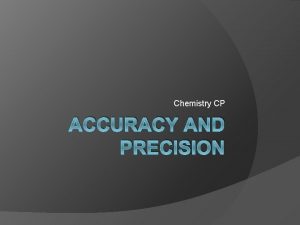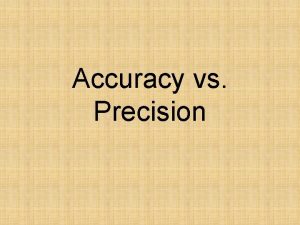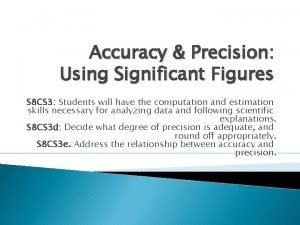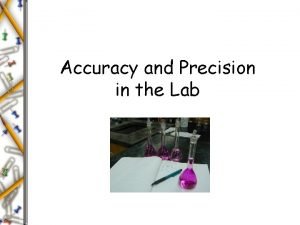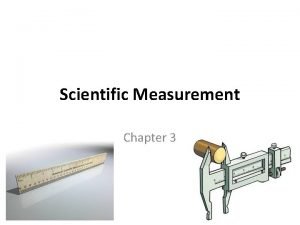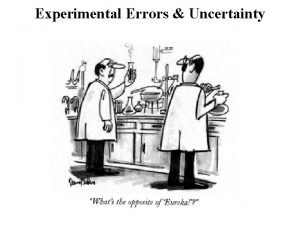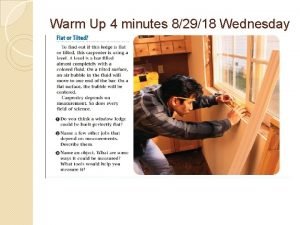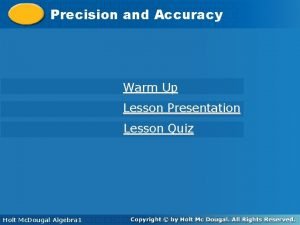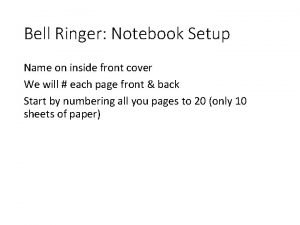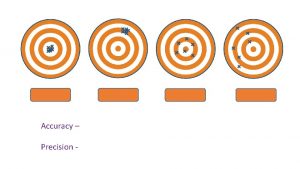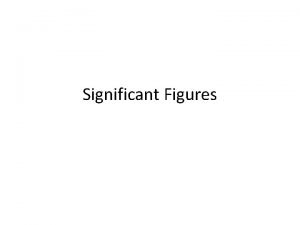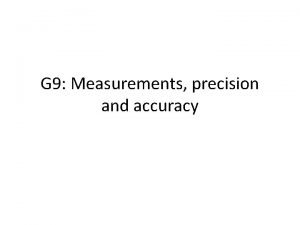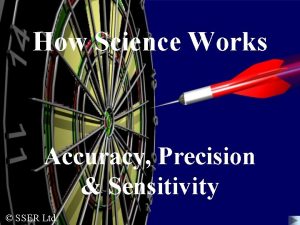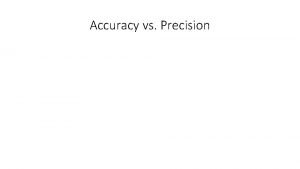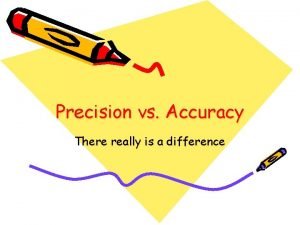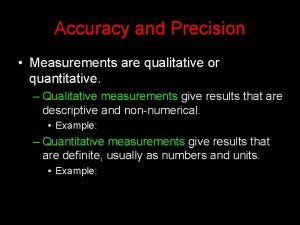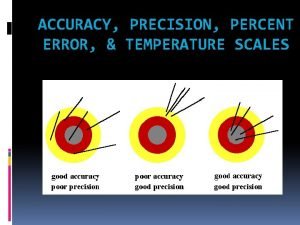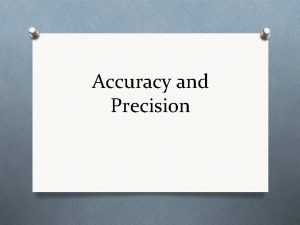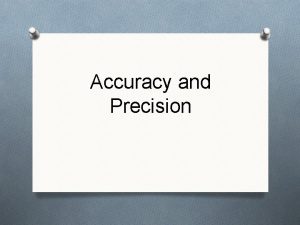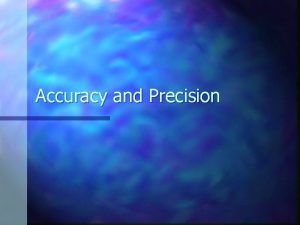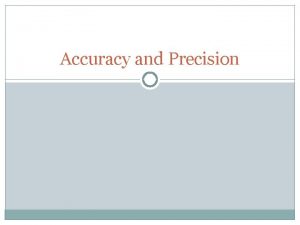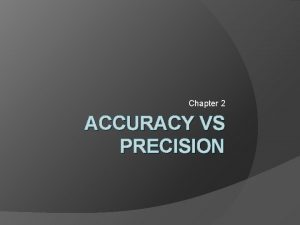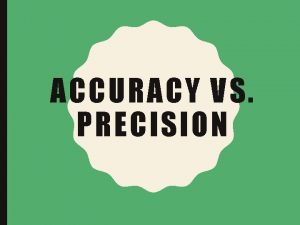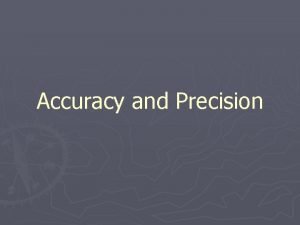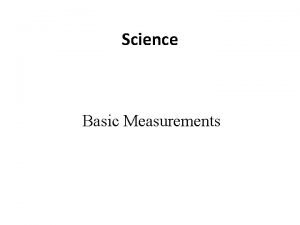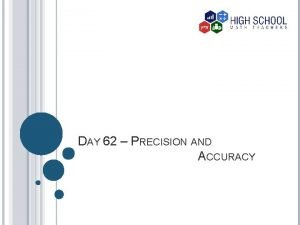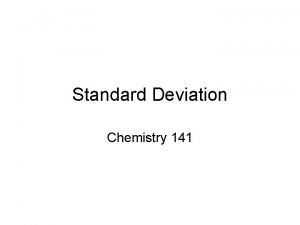Write Precision and Accuracy Write Precision and Accuracy





















- Slides: 21

Write Precision and Accuracy

Write Precision and Accuracy • Precision – How close multiple measurements are to each other. • Accuracy – How close a measurement is to the actual value.

Answer

Write Accuracy or Percent Error Actual Value Measured Value 5. 55 cm 6 cm %Error = Actual Value - Measured Value X 100 Actual Value %Error = -8. 11 5. 55 cm - 6 cm 5. 55 cm -6 cm / 5. 55 cm X 100 = -8. 11% X 100

Write Skill: How to Measure Precision Team 1 Team 2 Team 3 Team 4 Team 5 Team 6 Team 7 2. 65 g 2. 75 g 2. 80 g 2. 77 g 2. 60 g 2. 65 g 2. 68 g 1. Find the mean of all your data 1. Add up all the results and divide by the number of teams 1. 2. 65+2. 75+2. 80+2. 77+2. 65+2. 68/7 1. 2. 72 g 2. Find the range of your data. 1. Subtract the highest value from the lowest value 1. 2. 80 -2. 60 1. 0. 20 3. Precision = mean +/- range 1. 2. 72 +/- 0. 20) 4. To be Precise you must be between: 2. 52 g and 2. 92 g 1. 2. 72 + 0. 20 = 2. 92 2. 2. 72 – 0. 20 = 2. 52

Listen Precise Not Precise 2. 00 Not Precise 2. 50 3. 00

Listen How to write really big numbers. • The number of bacteria on earth is estimated to be: • 5, 000, 000, 000 • Is there an easier way to say and write this number?

Listen Scientific Notation • Yes • You can write 5, 000, 000, 000 • Or • 5. 0 X 1030

Write DATA ANALYSIS

Write Data Analysis • Data Analysis – Using logic to interpret and visualize data. • Graph – A diagram showing relationships between data points



Write Graphing • All graphs must have: – A title – A labeled X axis (Independent Variable or constant) – A labeled Y axis (Dependent Variable)

Write Skill: Graphing 1. 2. 3. 4. 5. Title your graph Determine your Y and X axis Draw your Y and X axis Label your Y and X axis Use your Data to find your range for your Y and X axis 6. Number your Y and X axis 7. Plot your data points 8. Draw your line/bar

Practice • Graphing: When you are graphing data you must title the graph, label the axis; the dependent (y) variable goes on the vertical axis and the independent (x, most constant) variable goes on the horizontal axis. When determining the scale of your graph, make the scale as large as possible within the limits of the paper. A line graph is used when a relationship between two variables is being studied, and a bar graph is used to look at comparisons of data. Temperature and the Breathing Rate of Freshwater Sunfish Table 2: Breathing rate of the freshwater Sunfish 10 15 18 20 23 25 27 Breathing Rate per minute 15 25 30 38 60 57 25 60 Breathing Rate Temperature (o. C) 50 40 30 20 10 5 10 15 20 Temperature 25 30

Write DIMENSIONAL ANALYSIS

Write Dimensional Analysis • Dimensional Analysis – Conversion of a measurement from one unit to another.

Write Dimensional Analysis • In order to do Dimensional Analysis you need: – The original measurement – The unit you want to get to – Conversion factors

Write Conversion Factor • Conversion Factor – A ratio that tells you how much of one thing is in another. – Examples: • • 1 foot = _____inches 1 inch = _____cm 1 yard = _____feet 1 kilometer = ______meter

Write What you want Given Measurement Conversion Factor Answer What you have How many seconds are there in a class period. 60 sec 92 min 1 min 5520 sec

Listen What you want Given Measurement Conversion Factor Answer What you have How many seconds old are you? 15 years 365 days 24 hours 60 min 60 sec 1 year 1 min 1 day 1 hour 473, 040, 000 sec
 Accuracy and precision in chemistry
Accuracy and precision in chemistry Accuracy v precision
Accuracy v precision Precision and significant figures
Precision and significant figures Uncertainty in multiplication
Uncertainty in multiplication Lab measurement accuracy
Lab measurement accuracy Quick lab accuracy and precision answers
Quick lab accuracy and precision answers Experimental error definition
Experimental error definition Brainpop precision and accuracy quiz answers
Brainpop precision and accuracy quiz answers Accuracy definition
Accuracy definition Passive instruments
Passive instruments Precision and accuracy
Precision and accuracy K h da b d c m
K h da b d c m Accuracy and precision
Accuracy and precision Accuracy and precision
Accuracy and precision Brainpop mindfulness quiz answers
Brainpop mindfulness quiz answers Sensitivity accuracy precision
Sensitivity accuracy precision Accuracy vs precision
Accuracy vs precision Precision vs accuracy chemistry
Precision vs accuracy chemistry Is accuracy qualitative or quantitative
Is accuracy qualitative or quantitative Flowcharting pmp
Flowcharting pmp High precision vs high accuracy
High precision vs high accuracy Equation for temperature
Equation for temperature
